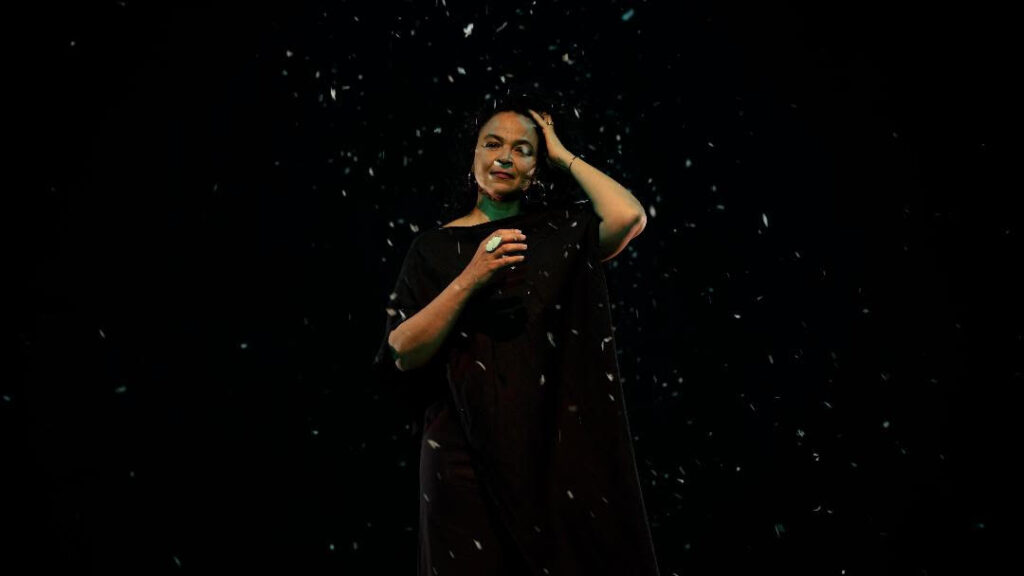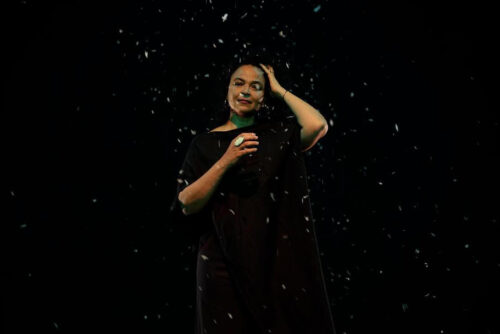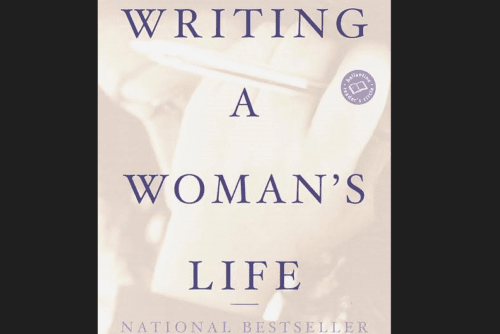Like racism and sexism, ageism is not about how we look. It’s about what people in power want our appearance to mean. Ageism occurs when a group, whether politicians or marketers or employment agencies, use that power to oppress or exploit or silence or simply ignore people who are much younger or significantly older.
– Ashton Applewhite, This Chair Rocks: A Manifesto Against Ageism
Living in a female body, a Black body, an aging body, a fat body, a body with mental illness is to awaken daily to a planet that expects a series of apologies to already live on our tongues.
– Sonya Renee Taylor, The Body Is Not an Apology: The Power of Radical Self Love
When Carrie Mae Weems sent me the picture she took of me for “The Shape of Things,” her 2021 show at the Park Avenue Armory, it came with an unintended, or so I believe, provocation: Here, you can use this for your women and aging project.

Earlier that year, I had invited her to contribute photographs to this issue of The Scholar and Feminist Online. She graciously said yes and, shortly after, asked me to participate in the show. The show would confront issues of identity and injustice, issues she had been exploring throughout her forty-year career. She put me in front of her camera alongside some phenomenal beings and then, there it was, the prompt: One picture of myself, an aging woman. This photograph proved to be the missing piece in my now years-long inquiry into aging. Up until that point, I had been absent in the conversation, instead describing and observing those other aging women as if, somehow, all this aging had nothing to do with me.
This journal issue aims to make visible the bodies of aging Women of Color in society and culture through an interdisciplinary framework that includes sociology, film studies, performance studies, photography, film, poetry, and dance.1 With Dr. Sheril Antonio, my co-editor, I sent a very open invitation to a group of very different writers and practitioners asking them to respond to the issue of aging for women of color, and looking for answers unique to each person’s experience. The resulting contributions include poetry, photos, interviews, essays, and, in my own case and a few others, films. What has come together in this issue is a conversation among friends with different creative and intellectual orientations, living in different cities and on different continents, talking together from our different perspectives about aging.
When Sheril and I first began this project, I intended for the issue to accompany the 2020 Moving Body-Moving Image Festival at Barnard College, a biennale festival of the moving body on screen, which I founded in 2018 and continue to direct. That year, the festival’s theme was Aging and Othering. That was the beginning of the pandemic. Then and during the ensuing societal reckoning when intersections of racism, ageism, and environmental oppression glared at us from every direction, it was evident that this special issue of S&F Online must be focused on Women of Color writing about Women of Color. The need was clear before the pandemic too. Even when selecting films to be included in the festival, it was hard to find ones where older Women of Color were strong and vibrant, where older people were full human beings.
The photograph Carrie Mae sent me in 2021 showed me to myself: An older woman, full-bodied, pictured in a masterful and evocative shot as only Carrie Mae can capture with her all-seeing eye. For me, however, what I saw was not the image I had of myself: A younger woman, still a dancer, a different body. The woman looking back at me was older, fuller, a grown woman. I barely recognized her. But I recognized the pandemic and the years of worry, the twenty pounds I had gained, the grief in my expression and how I held my body. The worry was about my parents, one living with dementia and one alone and lonely, far away. The grief was about all we had lost, all the people, the work, the performances and tours canceled, and a world so difficult to manage when Carrie Mae took that picture in April 2021, one year into the crisis. The photo also made me very aware of the frailty of life, the short time we have to be here, and the fact that, for me, half of it was now over. If I am to be so lucky.
Why was it that until then I had managed to separate myself from other aging women? In part, it was inherent to the trajectory of my investigation into aging, which started several years ago when my mother was diagnosed with dementia. As I explored my own beliefs about what it means to age in this society and in my world as a dancer and filmmaker, clarity emerged, but only gradually. Faced with the reality of my mother’s limited time and memory, I took a deep dive into her life through a series of oral histories that culminated in my one-woman multi-media performance, Magdalena. With this piece, I wanted to take away the stigma around dementia, and offer compassion for those living with it and those who care for and love them. Above all, I wanted to tell my mother’s story to make her visible to all. She was an adventurous, smart, white woman from the Netherlands who married my dad, a Black, mixed-race man from Suriname, moved with him to the Caribbean, gave birth to my brother and me, and raised us.
The research into my mother’s life led to an Atlantic Fellowship for Equity in Global Brain Health (GBHI). The fellowship included a year-long interdisciplinary training program on understanding dementia through neuroscience, health equity, trauma studies, and more. The research and training deepened my awareness of the invisibility aging women face, as well as societal beliefs about aging in general. I also became painfully aware of the lack of representation of diverse bodies and the bodies of Women of Color in particular, such as my own. Dealing with stories of dementia and trauma made me think again about how trauma lives in the body. I had seen this in my mom when, in the late nineties, she broke her leg in a bike accident. A flood of stories of her World War II trauma surfaced. The leg she broke falling off her bike was the same leg that had broken in the 1940 bombing of Rotterdam in which she was the only survivor.
I spent much of 2020 and 2021 studying how trauma lives in the body through Resmaa Menakem’s My Grandmother’s Hands (2017), which describes the somatic and neurological legacies of racial trauma, and Bessel van der Kolk, whose groundbreaking book, The Body Keeps the Score (2014), introduced me to epigenetics. I found myself wondering if perceptions about aging, both internalized and societal, are themselves traumatizing. What happens to women when society devalues them over time? What happens when they are no longer deemed valuable? What happens when they become invisible? Women of Color in particular, including trans, queer, big-bodied, and aging women, face a paradox of invisibility and hypervisibility in this society. We have all been bombarded with images of white, young, skinny women selling products to make us stay young, lose weight, and above all remember we don’t count if we don’t replicate this picture. And if we didn’t?
What did my peers and others think about the invisibility and ageist portrayal of older women in their fields, on stage, in film, and in other media? If talking about dementia and brain health is stigmatized, would talking about aging be any easier? How important is it to see oneself portrayed accurately? I knew that for me, growing up as a young woman studying dance in the Netherlands where I was one of very few people of color in my dance department, it was essential to find other choreographers of color. I had many incredible teachers, but I needed examples of women who looked like me, women like choreographers Pearl Primus and Katherine Dunham and writers Audre Lorde and Maryse Condé, who became my long-time mentor. These women were critical to my development as a Brown woman from the Dutch colonies working in a sea of white faces. They shaped my identity as a post-colonial woman and my work as an artist. When I started making films, I found role models there, too, although none who skipped film school to just do it, as I did. Nowadays, the accessibility of phones with great cameras and the existence of social media has made it easier for people to make work without the barrier of formal education. Hopefully this will help change the landscape of filmmakers and the diversity of stories told. But back then, I did not see many Black and Brown faces on screen or behind the camera. Now, decades later, I am sure representation still matters.
I’m making these observations about representation because we all age and our society as a whole is aging at a faster rate than previous generations. I believe it is crucial for all of us to see an accurate reflection of ourselves on screen, on stage, and in society—not just the young, the able-bodied, the white—a reflection where we are valued and equal. As it is, Women of Color are not regarded as equal and strong on screen or in society, and many of us don’t expect to find such representations of ourselves unless we make them.
Although I don’t see m/any accurate portrayals of older women, and specifically Black, Brown, Indigenous, and Latinx women in the mainstream media landscape. In my own world, here in New York City and beyond, I am surrounded by women in their sixties, seventies, eighties, and even nineties who live that example. These women inspire me. They show me that age is not a limit. Among them I think of MacArthur-winning photographer Carrie Mae Weems, musician Nona Hendryx, scholar and dancer Brenda Dixon Gottschild, dancer Carmen de Lavallade, writer Maryse Condé, choreographer and dancer Germaine Acogny, dancer and painter Awilda Sterling-Duprey, and dancer Sheila Rohan, who is the subject of two pieces in this issue, my experimental documentary and an essay authored by her niece Diedra Harris-Kelley. What these women have in common is curiosity and a drive to keep creating, inventing, and pushing boundaries in their work. They are also all artists, and maybe that makes them resilient and comfortable following their own guidance.
In October 2019, I went to see Sheila Rohan perform with her peers in the 5 Plus Ensemble at City College’s Aaron Davis Hall. The 5 Plus Ensemble was started by Carmen de Lavallade and Hope Clarke as a vehicle for mature dancers of color to continue their professional practice. During the performance, I was struck by how, with age, the performers had developed stronger presences on stage. The choreographies were not about age or decline but about dance. They were unapologetic. I was inspired, strengthened by the possibilities they presented. Here they were, older Women of Color, just like Anna Halprin and other white women who had come before, refusing to adhere to the silent rules of Western concert dance that tell us older women don’t dance, that elderly women should remain an invisible presence, that the fixation on youth should go unchallenged.2 As I thought about it, I wondered if their ability to set this trend was a continuation of what they had always done, having had the resolve to create the work they wanted to create in spite, or because, of being Black, Brown, older, and a woman.
Ultimately, I’m grateful that Carrie Mae presented me with her provocation just as I undertook this journey. True, I spent a day avoiding the photograph, wishing I was still as thin and agile as my younger self, but then I came back to my essence as a curious, adventurous, and open-minded human. I embraced the picture and ran with it. The spirit of who I am lives in me. As Ashton Applewhite says, “As the years pass, we remain ourselves, just older.”3 And my motto has always been that life is for growth. That hasn’t changed.
I’ve grown through this process, writing and reading and having conversations with my friend and co-editor, Sheril. Confronting change is never easy. Looking at your own aging body is confrontational. Thinking about ageism makes you think about nearing an end. These are difficult feelings. But a few weeks ago, in my home country of Curaçao, when I put on my bright yellow string bikini and went to the beach with my high school friends who were mostly covered up in one-piece suits, as expected, I felt free. I enjoyed feeling my older, fuller body, the air and the sea, my jiggles, my veins, my drooping breasts, my body that still moves easily.
The aging body is not an apology. It is a body with many stories and so much to give. As an older female artist, I’m as curious and motivated to create and innovate as I was when I was young. I also appreciate that the cat-calling has stopped, that I feel safer while traveling alone. But, as I’ve learned talking to friends and diving into ageism over the past five years, being older is a gift. It is freeing. I hope the conversations in this issue of S&F Online will contribute to a wider and essential dialogue spurring individual and collective growth and equity, making these beautiful, aging bodies visible.
WORKS CITED
Applewhite, Ashton. This Chair Rocks: A Manifesto Against Ageism. New York: Celadon, 2019.
Menakem, Resmaa. My Grandmother’s Hands: Racialized Trauma and the Pathway to Mending Our Hearts and Bodies. Las Vegas: Central Recovery Press, 2017.
Ross, Janice. “Dance and Aging: Anna Halprin Dancing Eros at the End of Time.” In The Aging Body in Dance: A Cross-Cultural Perspective, edited by Nanako Nakajima and Gabriele Brandstetter, 137-148. London: Routledge, 2017.
Taylor, Sonya Renee. The Body Is Not an Apology: The Power of Radical Self-Love. Oakland, CA: Berrett-Koehler Publishers, 2018.
Van der Kolk, Bessel. The Body Keeps the Score: Brain, Mind, and Body in the Healing of Trauma. New York: Penguin, 2015.
Weems, Carrie Mae. Gabri Christa. Photograph. 2021. Digital file.
- I use the term Women Of Color in this essay to be inclusive of all the writers and contributors to this issue coming from India, China, Guyana, and the Philippines, as well the US as people of African descent. I myself experience a fluid identity: In the US, I am described as Black, but in the global context I am a post-colonial, Caribbean, Woman of Color, hence my choice. [↩]
- Ross, Janice, “Dance and Aging: Anna Halprin Dancing Eros at the End of Time,” in The Aging Body in Dance: A Cross-Cultural Perspective, eds. Nanako Nakajima and Gabriele Brandstetter (London: Routledge, 2017), 140. [↩]
- Ashton Applewhite, This Chair Rocks: A Manifesto Against Ageism (New York: Celadon, 2019), 39. [↩]




